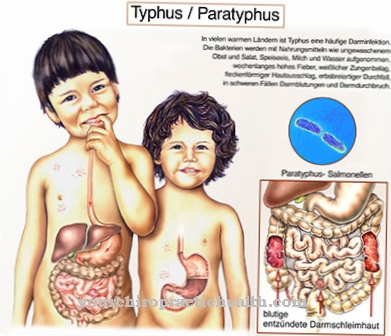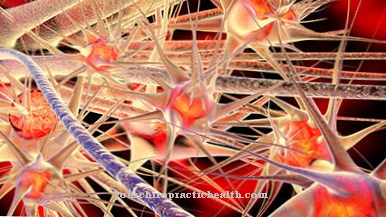Under Squint or also in technical terms Strabismus called, one understands a misalignment of the eyes that look in different directions. The eyes can either be both inward or outward.
What is squint?

© VectorMine - stock.adobe.com
The Squint is not only a "cosmetic blemish" for many people affected, it can also be a visual impairment.
Since one of the two eyes is no longer parallel to the other when squinting, they both look in a different direction. The deviation can take place in any direction, but the horizontal deviations most often occur, which lead to either inward or outward strabismus.
Since strabismus without treatment can lead to severe visual impairment in a healthy eye, timely treatment is particularly important for children. The strabismus can be divided into three forms: the latent strabismus, the accompanying strabismus and the paralysis strabismus.
causes
The Squint can have different causes; this also depends on the shape of the squint. The cause of the accompanying strabismus and the latent strabismus lies in a disturbed equilibrium of the eye muscles.
There are no specific reasons for the concomitant strabismus, but genetic factors also play a role. Often one finds another person in the relatives of the person concerned who is cross-eyed or has crossed before.
Farsightedness or myopia can be present at the same time. With latent strabismus, the eye cannot merge the visual impressions so well, which occurs especially when the eyes are tired or strained for a long time.
With paralysis strabismus there is paralysis of the external eye muscles, which can be caused, for example, by birth injuries, tumors, inflammation or circulatory disorders.
Symptoms, ailments & signs
Due to their stage of development, small children can suppress the visual impression by squinting for a certain period of time. Suppression is a protective mechanism and prevents double vision. However, long-term suppression of the deviant eye provokes the development of amblyopia (weak vision). This affects children with a one-sided shift in their gaze.
The more dominant and frequently used eye is preferred by the brain. As a consequence, the visual performance of the inferior eye atrophies over a longer period of time. The waste is sometimes so drastic that even large objects can only be recognized with difficulty. A similar course can be observed at a young age in the so-called paralysis deformity.
In general, squint not only leads to an aesthetic impairment, but also always leads to a visual impairment. The first signs of strabismus are expressed in trembling eyes and a crooked head position. Sensitivity to light, frequent cases of headaches and a drop in concentration also occur. Burning eyes and constant blinking accompany a reading weakness that manifests itself afterwards.
Latent strabismus only comes to light under certain influencing factors such as stress, overexertion or alcohol consumption. This hidden variant ensures rapid fatigue and blurred visual impressions with a tendency to double contours or images. This description applies especially to later acquired strabismus in adulthood.
Symptoms of paralysis in adults lead to a sudden squint and sudden visual impairment (double vision) in combination with nausea and dizziness. Those affected often adopt a compensatory head position to relieve the diseased eye.
Diagnosis & course
The visible deformity of the eyes is a Squint can be diagnosed quickly. In order to be able to determine the squint precisely, various eye tests are carried out, such as the covering or uncovering test.
One eye is covered and the doctor can then observe whether the other eye can readjust itself; in this case it is an accompanying strabismus. The uncovering test determines whether the eye is moving too slowly during the fusion and whether there is a latent squint.
The tests described can also be used to detect other visual disorders. The further course of the squint depends, among other things, on early therapy. For example, the secondary strabismus in childhood without treatment can lead to permanent ametropia, which can then no longer be remedied from elementary school age. For this reason, squinting should at best be recognized in preschool age so that the prognosis for sharp and spatial vision is as good as possible.
Complications
If left untreated, strabismus in children can have serious consequences. Often the eye that is not in use develops pronounced visual impairment, which persists without timely countermeasures. This is usually accompanied by headaches, which can develop into a chronic migraine. If the squint appears later in life, significant vision problems can occur.
A restricted view increases the risk of accidents and generally restricts those affected considerably in everyday life and at work. Squinting also has psychological consequences. The affected person often suffers from exclusion and as a result often develops an inferiority complex or depression. Surgical treatment of strabismus can lead to loss or blindness. Injuries to the eyeball as well as bruises and scars are also possible.
Very rarely does vision deteriorate after surgery. Under certain circumstances, the squint is over- or under-corrected and the double vision persists or even increases. There is also a risk of over- or under-correction with aids such as squint glasses. Shortly after the procedure, complications such as pain, bleeding, or inflammation of the eye are possible.
When should you go to the doctor?
The squinting of one eye is not an independent clinical picture, but a symptom of an underlying disease. In most cases, an eye squint occurs at birth. One eye has more eyesight than the other, so it can squint. An appropriate specialist should be consulted immediately and without delay so that complications do not arise in later years. The eyesight may deteriorate, so that the squint can intensify within a short time. However, with appropriate treatment, strabismus can be treated effectively and quickly.
The course of the disease is completely different if you do not visit the doctor. In this case, the squint becomes stronger and vision can even be impaired. If a specialist is still not consulted, in the worst case scenario it can lead to loss of vision. If you want to avoid these and other complications early on, you should consult a doctor early on.
Treatment & Therapy
Even in therapy against Squint the shape is crucial. The treatment of the accompanying squint focuses on stereo vision, which means that the merging of visual impressions and spatial vision succeeds better again.
In addition, the malocclusions will be corrected in the normal position. Squinting in children is always treated conservatively at the beginning. For example, with the help of glasses and certain eye training, which should improve the fusion or the merging of individual visual impressions.
What is also used to improve the misalignment of the eye is occlusion therapy, in which one eye is alternately covered with a plaster. However, this masking must be done according to a certain schedule. The weaker eye is thus forced to see and children can learn to see well again.
In adults, fusion training is achieved by gluing a matt film onto a spectacle lens. Thus, double vision can be prevented. Anyone suffering from severe strabismus can also consider eye muscle surgery.
This procedure is often carried out when two-eye vision can no longer be achieved through conservative therapy. The paralysis squint is treated similarly, if it does not resolve on its own after several weeks.
You can find your medication here
➔ Medicines for visual disturbances and eye complaintsprevention
The Squint cannot be prevented. The consequences of existing strabismus can only be reduced prophylactically by starting therapy at an early stage. This mainly applies to children, as strabismus occurs and is diagnosed especially in childhood.
In the case of strabismus, consistent follow-up care is advisable to avoid a possible recurrence of symptoms after successful treatment. This is especially important in children, as the condition of the eyes changes with their age. If the strabismus should come back after a completed therapy, further treatment options will be discussed as part of the aftercare. A second operation may be necessary.
Aftercare
Follow-up care after an operation against strabismus is useful to monitor the healing process. Therefore, the patient will see his ophthalmologist about a week after the operation. The follow-up examination will check to what extent the eye has already swollen and the current condition after the operation corresponds to expectations.
In addition, the ophthalmologist deals with the usual complaints after an operation during follow-up care. The wound pain in the operated eye is counteracted with the help of drops or medication. The conjunctiva is swollen after a squint operation. Regular monitoring is important to prevent inflammation and irritation or to treat them.
With cross-eyed children, the ophthalmologist will do exercises to improve eyesight and thus improve the condition of the eyes permanently. This school of vision is used for children up to 15 years of age. Then the visual acuity no longer changes.
You can do that yourself
In everyday life, the environmental influences when reading, working on a screen or watching television should be tailored to the natural needs of the human eye. The lighting conditions must be checked and the distance between people and a readable element should be optimized. Both bright and dark lighting conditions are more demanding on the human eye than is advisable. This can lead to problems or further impairment of vision.
If the squint is not very pronounced, you can strive for improvement through targeted eye training on your own. Reading with only one eye is a common technique that can be used independently at any time. Alternately, texts or images should be fixed with the right and then with the left eye. Overall, it must always be ensured that both eyes are stressed equally as much as possible. Overloading only one eye should be avoided.
In children in particular, the misalignment of the eyes can be corrected by specifically influencing the visible area. A consciously strived for and self-initiated squinting of the eyes should be avoided by people of any age. This process can exacerbate existing problems and have a negative impact on any therapy.


.jpg)



.jpg)




















